EMR Final Exam Questions and Answers
Document Content and Description Below
EMS System - ANSWER A network of resources to provide emergency care and transport victims of sudden illness and injury Enhanced 911 System - ANSWER Allows caller to be identified by the dispatch s... ystem by providing the callers phone numbers and address from which they are calling Seven Levels of EMS training - ANSWER 1. Emergency Medical Responder (DOTrans, Basic, Advanced) 2. EMT Basic 3. AEMT (Advanced EMT) 4. Intermediate 85,99 5. EMT Paramedic 6. Critical Care Paramedic 7. TEMS (Tactical EMS) Five Roles / Responsibilities of the EMR - ANSWER 1. Personal Health and Safety 2. Caring Attitude, Maintaining Composure 3. Neat, Clean, and Professional Appearance 4. Keep Up to Date knowledge and skills 5. Put Patients needs as a priority Eustress - ANSWER Good Stress Distress - ANSWER Bad Stress Five Common Causes of Stress - ANSWER mass casualty violence amputations death Pediatric patients Five Stages of the Grieving Process - ANSWER 1. Denial (Disbelief) 2. Anger 3. Bargaining 4. Depression 5. Acceptance Five Signs of Stress - ANSWER irritability can't concentrate difficulty sleeping anxiety (guilt) loss of appetite Four Lifestyle Changes to Deal with Stress - ANSWER 1. Eat healthier 2. Exercise (Meditation) 3. Balance Work 4. Listening to Family and friends CISD - ANSWER Critical Incident Stress Debriefing Critical Incident Stress Debriefing: Purpose - ANSWER Deals with Traumatic Incidents, a debriefing is a confidential group meeting which encourages open discussion of the incident. The goal is to assist the EMS personal in dealing with the stress related to the incident Four Types of Body Substance Isolation - ANSWER Hand washing Proper disposal of medical equipment use of personal protective equipment Scene Safety (?) Scene Safety - ANSWER Assessment of scene (surroundings) that will provide information to the first responder and will help ensure their well-being Scope of Practice - ANSWER The legal duties to the patient, medical director, and public Standard of Care - ANSWER care expected based on training and experience taking into account the conditions under which the care is rendered Competence - ANSWER The ability to understand questions and to the implication of decisions made ( do you know who / where / what you are? ) Expressed Consent - ANSWER The patient must be told in an easy to understand nature and the extent of the procedure to be preformed as well as the possible risks involved Implied Consent - ANSWER Consent based on the assumption that the unresponsive patient would consent to life saving interventions Advanced Directives - ANSWER Written documentation that specifies what medical treatment a patient wishes to have and what to withhold should the patient become unable to make a decision Assault and Battery - ANSWER Unlawfully touching a patient without consent providing emergency medical care when a competent patient does not consent to the emergency medical care Abandonment - ANSWER Terminating care of the patient without insuring that care will continue at the same level or higher Four Components of Negligence - ANSWER 1. Duty to act (legal obligation) 2. Breach of Duty (failure to act) 3. Injury where Inflicted (some injury occurred) 4. Proximate Cause (the actions of the EMR caused injury) Negligence - ANSWER Deviating from the accepted standard of care resulting in further injury of the patient Good Samaritan Law - ANSWER State Laws intended to protect care providers from liability if they deliver the standard care in good faith to the level of their training and to the best of their ability. Don't protect from Wanton, Gross, or Willful Negligence Anatomical Position - ANSWER body is erect facing forward, arms are at the sides palms face forward Anterior / Posterior - ANSWER Front / Back Medial / Lateral - ANSWER Toward the Middle / Toward the side Superior / Inferior - ANSWER Toward the Head / Toward the Feet Skeletal - ANSWER Gives the Body its shape protects vital internal organs Axial - ANSWER Skull only movable bone is the mandible Muscular - ANSWER Gives the Body shape Protects interal organs provides for movement Muscles are Voluntary (cardiac is involuntary) Respiratory - ANSWER Delivers oxgen to the body removes carbon Circulatory - ANSWER Delivers oxgen and nutrients to the tissues and removes waste products from the tissues Central Nervous System - ANSWER Brain and Spinal Cord Peripheral Nervous System - ANSWER Does not regenerate when injured Skin - ANSWER Protects the body from the environment, bacteria and other organisms regulates temperature and prevents dehydration Senses heat/cold touch pressure and pain transmits to the brain and spinal cord The Breathing Process - ANSWER Trachea to Bronchiole Tubes to Bronchiole to Alevoli Body Mechanics - ANSWER The proper use of the body to facial lifting and moving to prevent injury Rules of Body Mechanics to prevent Injury - ANSWER weight of patient and need for help know your physical ability and limitations lift without twisting and feet properly communicate clearly with partner Reasons for using an Emergency Move - ANSWER immediate danger to the patient if not moved life saving care cant be given further injury is potential Lifting techniques - ANSWER The Firefighter's Carry Blanket Lift Drag Direct Ground Lift Chair Lift (Extremity Lift) Recovery Position - ANSWER Left Side Unresponsive without trauma Right Side Unresponsive without drama Allow the patient to assume a position of comfort Injuries which require spinal immobilization - ANSWER Spine Neck Head Clinical Death - ANSWER The moment that breathing and heart activity stops, this death can be reversed Biological Death - ANSWER Death of brain cells this death irreversible occurs 6-10 minutes of respiratory arrest Brain Damage begins - ANSWER within 4 to 6 minutes opening the air way: unresponsive, gag reflex - ANSWER Nasal Airway Using a Nasal Airway - ANSWER measure nose to corner of mouth insert longer side down right nostril one breath every 5 seconds (adult) opening the air way: unresponsive, no gag reflex - ANSWER Oral Airway Using an Oral Airway - ANSWER measure earlobe to corner of mouth insert curved part up until tension is felt then rotate and insert rest of the way One breath every 5 seconds (adult) Maintain an Open Airway - ANSWER Nasal Airway Oral Airway Open a patient's Airway - ANSWER Head Tilt / Chin Lift Jaw Thrust Clearing an Airway - ANSWER The Recovery Position Finger Sweeps Suctioning Max Suction Time - ANSWER adult 15 sec child 10 sec infant 5 sec Normal Resp. Rate - ANSWER adult 12-20 breaths pm child 15-30 breath pm infant 25-50 breath pm Five Methods for Ventilating a Patient - ANSWER mouth to mask two person valve mask mouth to barrier device one person bag valve mask mouth to mouth Rates for Rescue Breathing (breath : second) - ANSWER Adult 1:5 Child 1:3-5 Infant :3-5 Newborn: 1:1.5 Oxygen Flow Rate: Non-rebreather face mask - ANSWER 12-15 liter per minute 80-95% oxygen Oxygen Flow Rate: Nasal Cannula - ANSWER 2-8 liters per minute 22-44% oxygen Five Components of Patient Assessment - ANSWER Scene Size Up Primary Secondary Reassess Patient Care Report Scene Size Up - ANSWER BSI Scene Safety Mechanism of Injury Number of Patients Additional Resources if Needed (EMR) CSI (Consider Spine Immobilization) Components of Primary Assessment - ANSWER General Impression (intro, whats the problem) Assess Responsiveness (AVPU) Check Airway, Breathing, Circulation (stop any bleeding if there is any) (ABC) Identify Priority Patients Update EMS AVPU - ANSWER Alert Verbal Pain Unresponsive DCAP BTLS - ANSWER Deformities Contusions (brusises) Abrasions (scrapes) Penetrations (puncture) Burns Tenderness Lacerations Swelling SAMPLE - ANSWER Signs and Symptoms (OPQRST) Allergies Medication Past Med History Last Oral Intake Event (what was going on before?) OPQRST - ANSWER Onset (when did it start) Palliation (what makes it better) Quality (describe pain) Radiation (does it spread anywhere else) Severity (1-10 scale) Time (when medical attention was needed) Chief Complaint - ANSWER main injury (cause for distress) Sign - ANSWER first responder observations (see hear feel smell in relation to the injury or illness) Symptom - ANSWER patient tells about how they feel Heart Attack - ANSWER failure of circulation to the heart muscle that damages or kills a portion of the heart (pressure on chest) shortness of breath is common as well Congestive Heart Failure - ANSWER medical emergency affects the lungs and heart occurs when the heart can not circulate blood properly. the fluid can lead to respiratory difficulty. may complain of swelling due to fluid build up Chronic Obstructive Pulmonary Disease (COPD) - ANSWER variety of lung problems related to disease including emphysema and chronic bronchitis. Usually occurs in middle age or older people. Altered Mental Status - ANSWER a sudden or gradual decrease in their responsiveness and understanding ranging from disorientation to unresponsiveness. Cerebrovascular Accident (Stroke) - ANSWER blocking (bursting) of a verse that supplies blood to the brain an inadequate supply of oxygen to a portion of the brain causing death Seizures - ANSWER Irregular electrical activity in the brain causing serious change in behavior and usually related to a nervous system malfunction. Rarely life threatening. Diabetes - ANSWER prevents individuals from producing enough insulin or utilizing insulin efficiently Hyperglycemia - ANSWER high blood sugar can produce a coma takes several days to develop Hypoglycemia - ANSWER low blood sugar caused by too high a level of insulin in the blood (produces a drop in blood sugar) Anaphylactic Shock - ANSWER Allergic Reaction Hypothermia - ANSWER general cooling of the body which creates a state of low body temperature Hyperthermia - ANSWER Heat Stroke Four Routes of Poison - ANSWER Ingestion Inhalation Absorption Injection Five Causes of Anaphylactic Shock - ANSWER bees food inhaled chemicals medicine Six Causes for Altered Mental Status - ANSWER Strokes Diabetes Heat Cold Seizures Poison Three Types of External Bleeding - ANSWER Arterial Venous Capillary Arterial Bleeding - ANSWER Blood Spirt (from wound) Bright Red (oxygen rich) Venous Bleeding - ANSWER Blood Flows (steady) Dark Red (oxygen poor) Capillary Bleeding - ANSWER Blood Oozes (clotting quickly) High Chance of Infection Abrasions - ANSWER damages the surface of the skin, but not all layers Lacerations - ANSWER Jagged cuts where tissue along the edge of the wound is torn and a rough edge is produced Puncture Wounds - ANSWER Puncturing objects tear through skin damages all tissues in its path, can be shallow or deep (internal bleeding) Sucking Chest Wounds - ANSWER puncture wounds to the chest patients may cough up blood the chest may collapse (lungs) (because air is in-between the lungs and check wall) Avulsions - ANSWER large flaps of skin are torn loose or off, replace before removing Amputations - ANSWER cutting or tearing off of the fingers, toes, hands, feet, arms, or legs Impaled Objects - ANSWER Object is still protruding from the body. Impaled Object should be removed when - ANSWER it impales the airway preforming CPR Evisceration - ANSWER abdominal organs protrude through soft tissue injury Four Quadrants of the Abdomen - ANSWER (going clockwise) right upper quadrant left upper quadrant right lower quadrant left lower quadrant Best Way to Control Bleeding - ANSWER Direct Pressure Amputated Part Care - ANSWER Put it in a bag or wrapped in something then on ice (NOT directly) Penetrating Chest Wound - ANSWER link n log (that bitch) Shock - ANSWER failure of the circular system to provide enough blood to the vital organs of the body Eight Types of Shock (RN CHAMPS) - ANSWER Respiratory Neurogenic Cardiogenic Hypovolemic Anaphylactic Metabolic Psychogenic Septic Respiratory Shock - ANSWER breathing shock from failure of the respiratory system Neurogenic Shock - ANSWER Nerve shock from failure of the blood vessels to constrict Cardiogenic Shock - ANSWER Heart Shock from damage to the heart Hypovolemic Shock - ANSWER Bleeding Shock from fluid loss Metabolic Shock - ANSWER Body fluid shock from loss of fluids from vomiting and diarrhea Psychogenic Shock - ANSWER Shock from fainting, from interruption of blood flow to the brain Septic Shock - ANSWER Blood Stream Shock caused by infections Signs of Shock - ANSWER altered mental status rapid or weak pulse skin is pale (cool clammy cyanotic) nausea (w/ vomit and thirst) dizziness Emergency Care for Shock - ANSWER wrap in blanket (heat) place the patient in a position of comfort (comfort) elevate legs (unless spinal injury) Three Types of Burns - ANSWER Superficial (first degree) Partial Thickness (second degree) Full Thickness (third degree) Treatment for Burns - ANSWER Stop burning process by flushing the burned area with cool water remove clothing around burned area (minor: wet dress major: dry dress) Mechanism of Injury - ANSWER a force or forces that may have caused the injury Three Forces that cause musculoskeletal Injuries - ANSWER ???? Fracture - ANSWER any break crack chip split or crumbling of a bone Dislocation - ANSWER occurs when one end of a bone that is part of a joint is pull or pushed out of place Sprain - ANSWER partial or complete tearing of a ligament Strain - ANSWER overstretching or tearing of a muscle Six Symptoms of a Fracture - ANSWER Deformity (angulation) Pain (Tenderness Numbness) Sound of Breaking Swelling Slow Capillary Refill Bruising PSD - ANSWER Pain Swelling Deformity Manual Stabilization - ANSWER to steady a body part in order to help reduce involuntary movement caused by pain or muscle spasms Five Symptoms of Spinal Injury - ANSWER Tenderness (in the area of the injury) Pain Associated with movement Numbness Weakness Loss of Bowel Control Five Symptoms of Head Injury - ANSWER Unresponsive Deep Cuts (or tears exposed brain tissues) Swelling and discoloration (under eyes) fragements of bone (through the skin) (Deformity of the Skull) Placenta - ANSWER Organ of pregnancy, composed of maternal and fetal issues (organ where exchange between mother and fetus occurs) Umbilical Cord - ANSWER structure that connects fetus to the placenta [Show More]
Last updated: 1 year ago
Preview 1 out of 18 pages
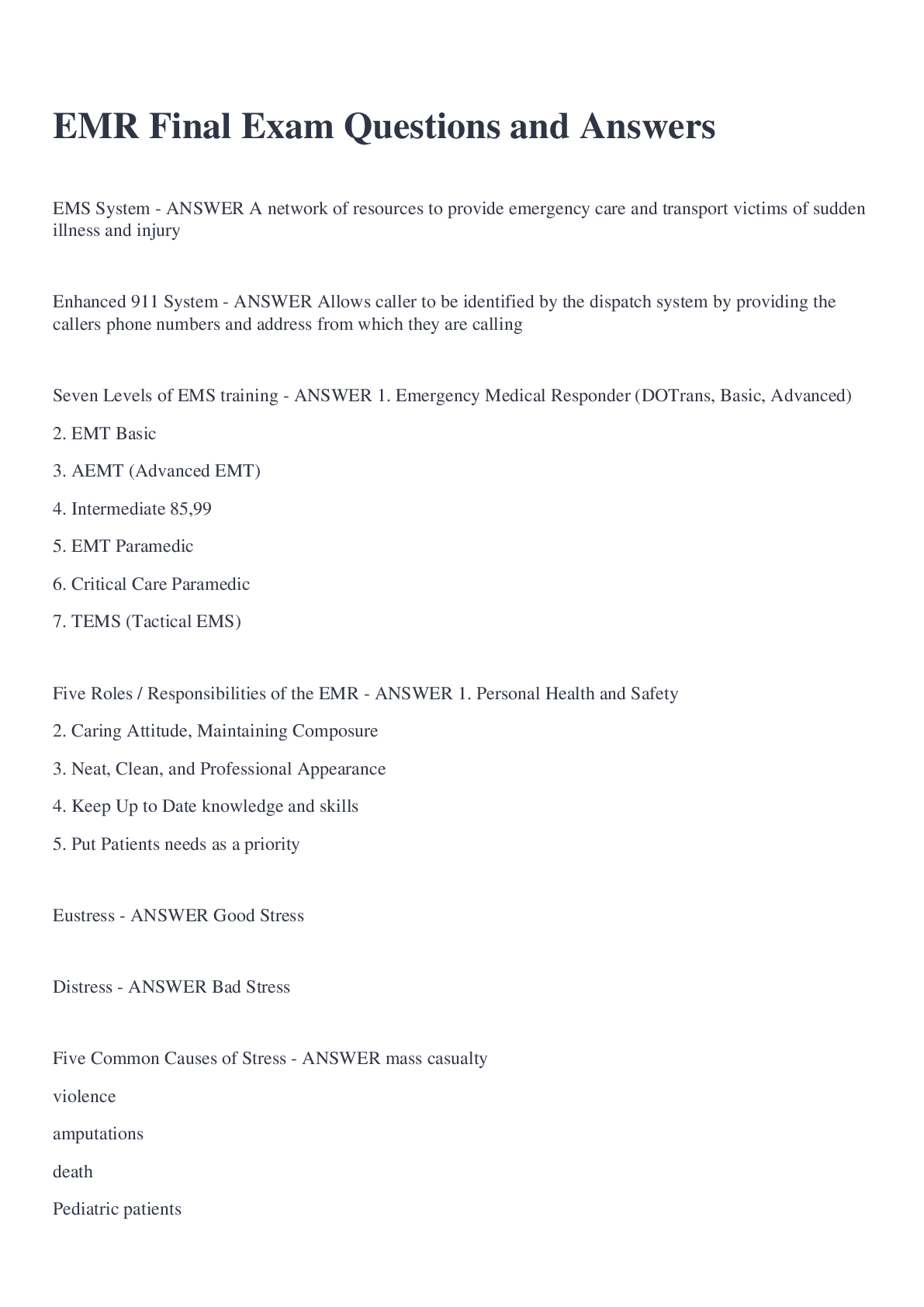
Buy this document to get the full access instantly
Instant Download Access after purchase
Add to cartInstant download
We Accept:

Reviews( 0 )
$8.00
Document information
Connected school, study & course
About the document
Uploaded On
Sep 05, 2022
Number of pages
18
Written in
Additional information
This document has been written for:
Uploaded
Sep 05, 2022
Downloads
0
Views
185

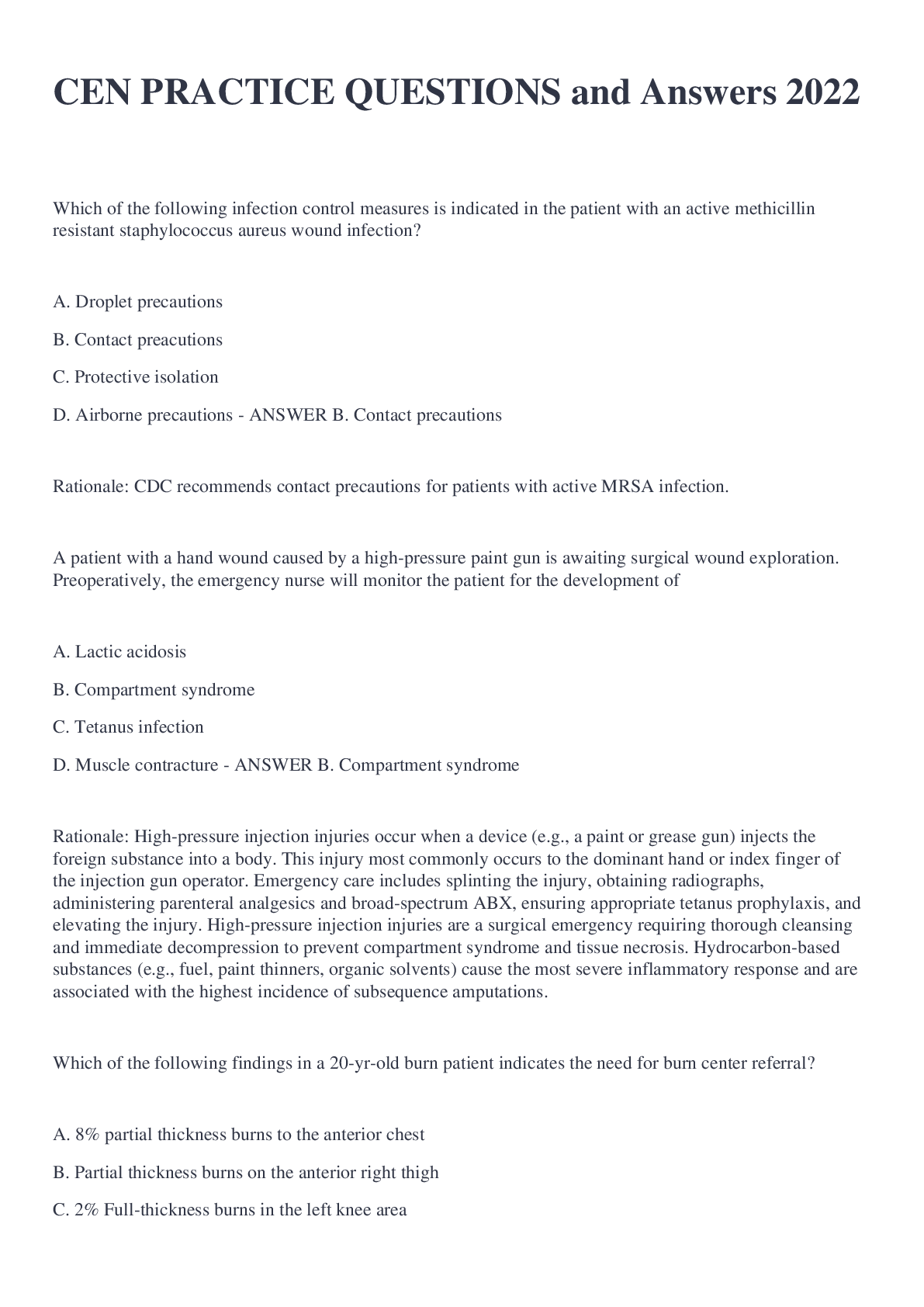


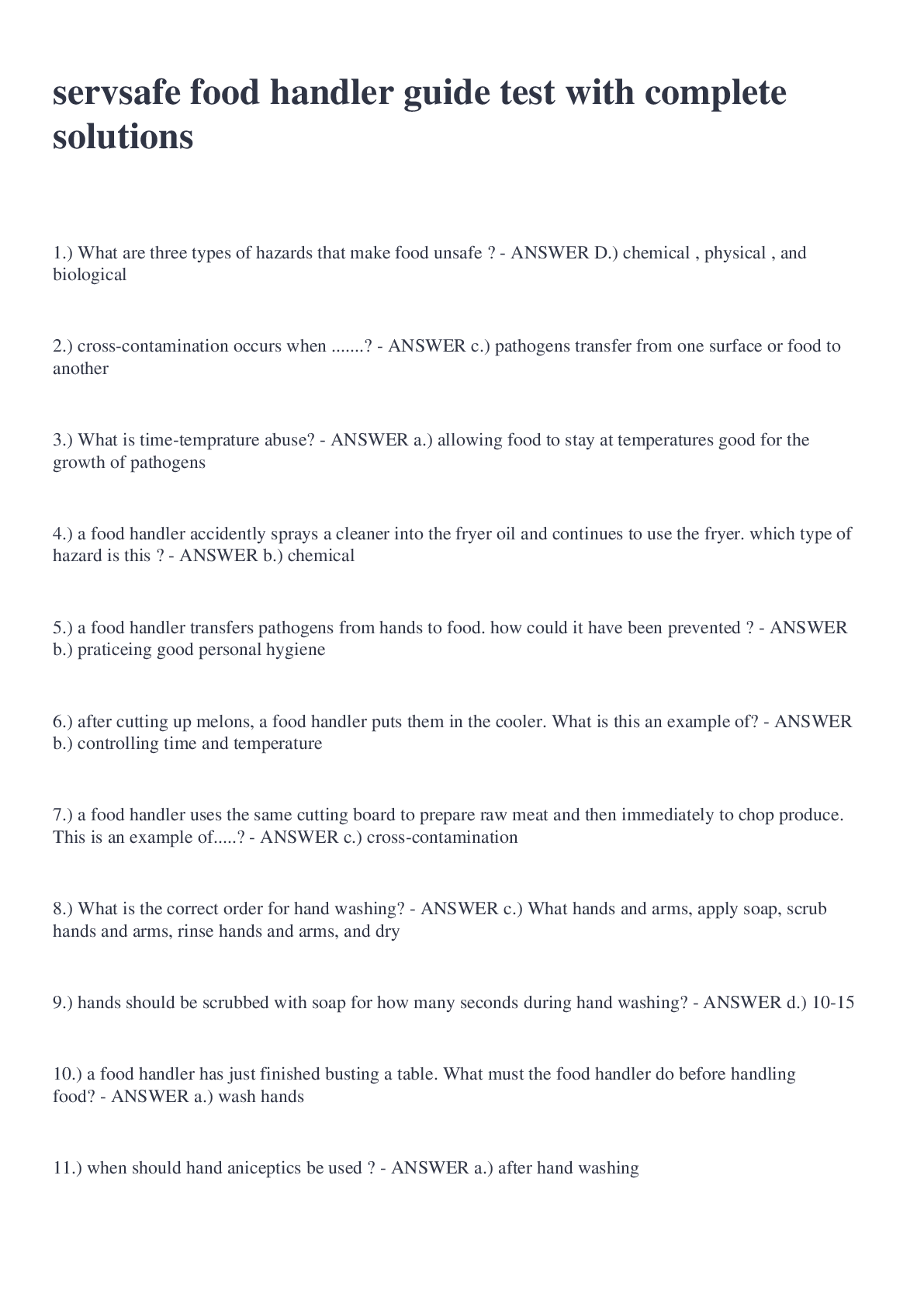


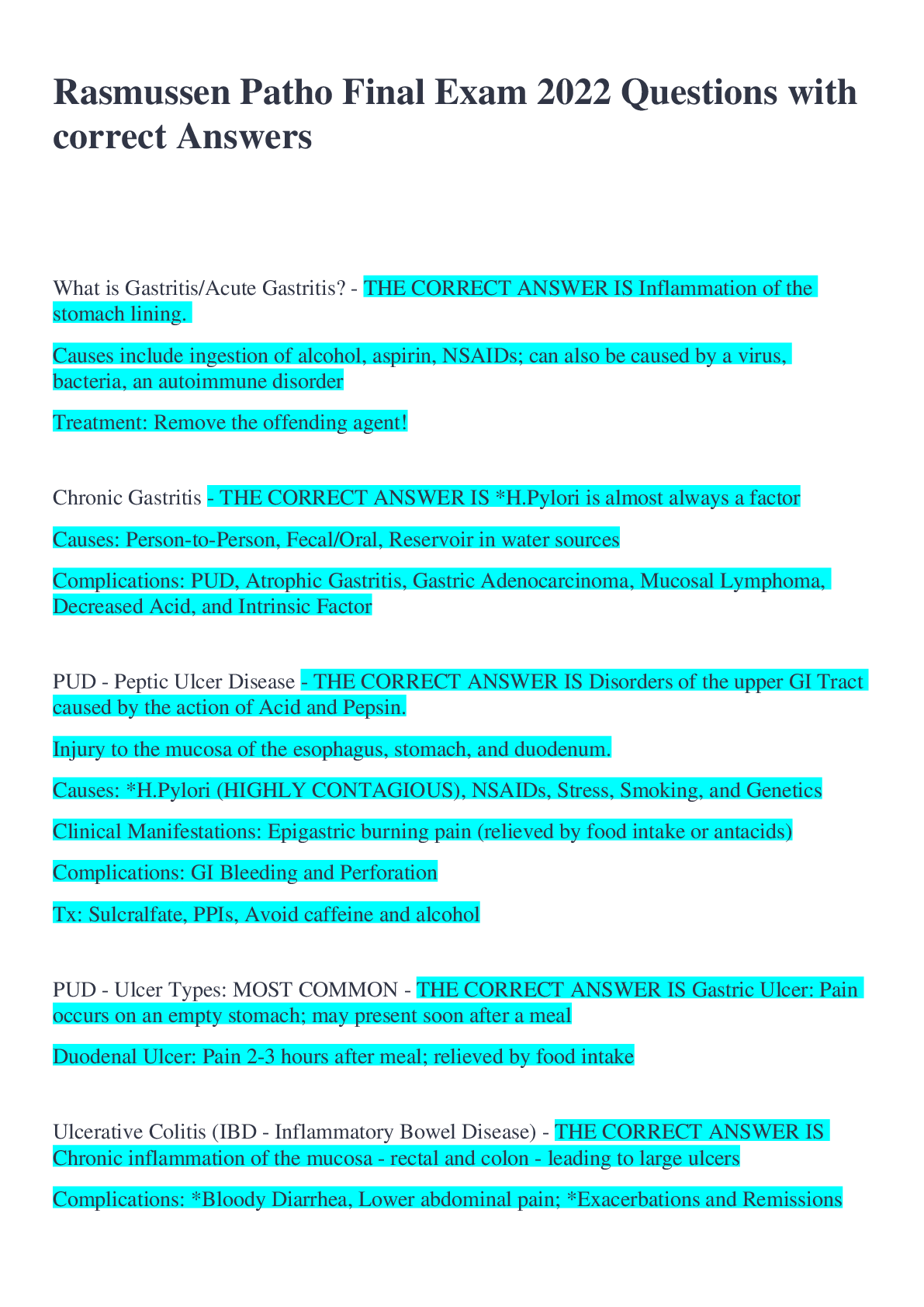
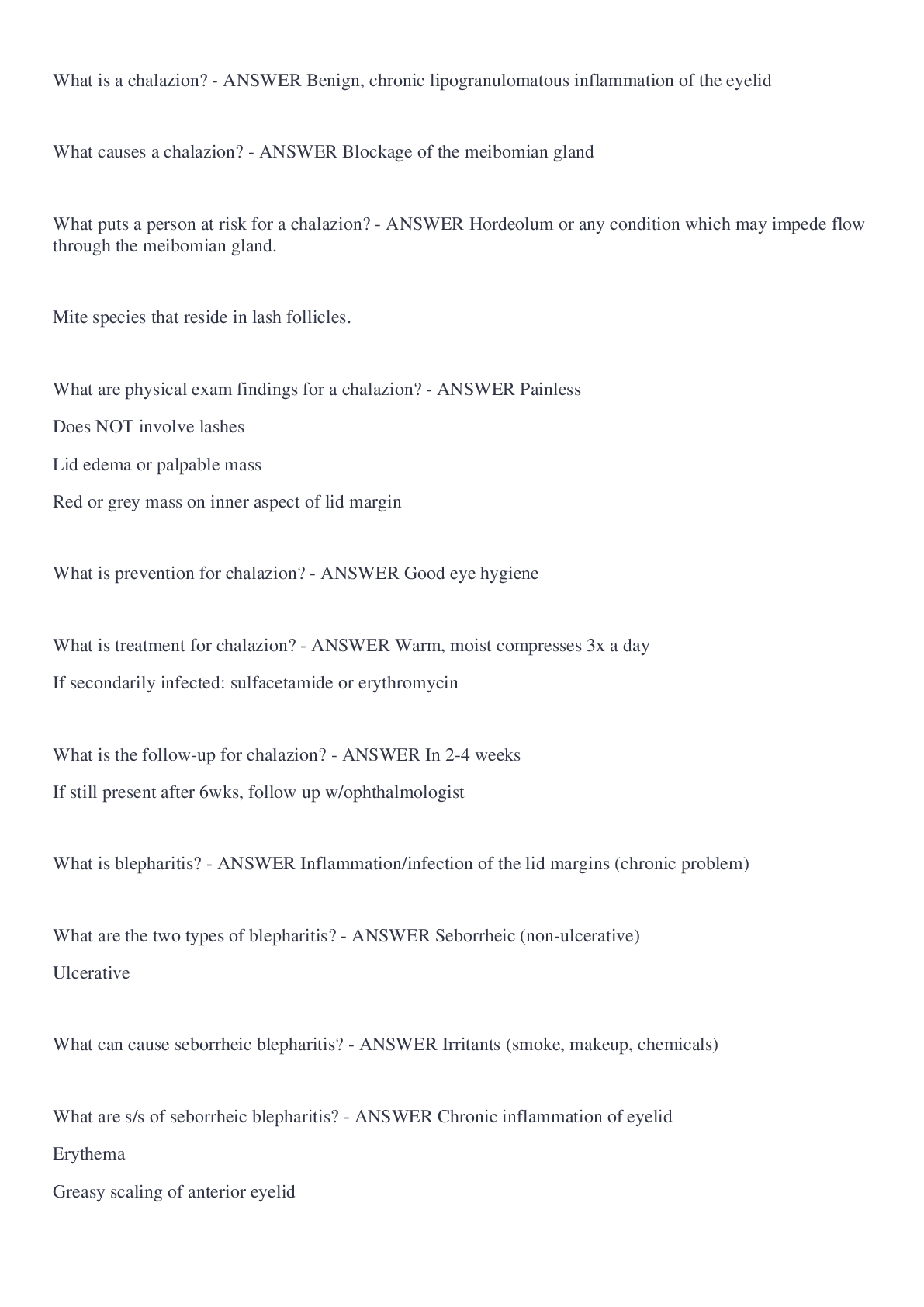
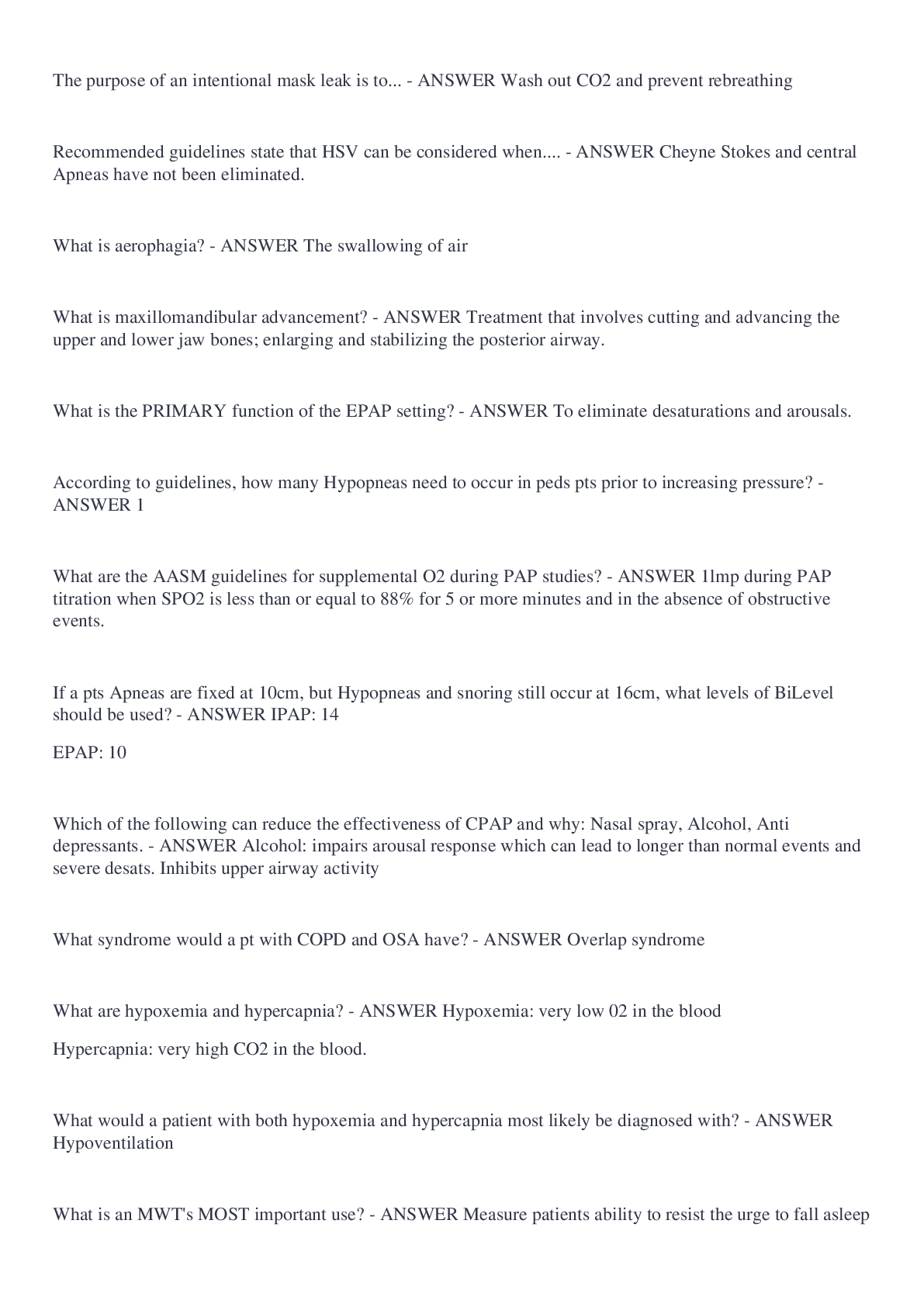



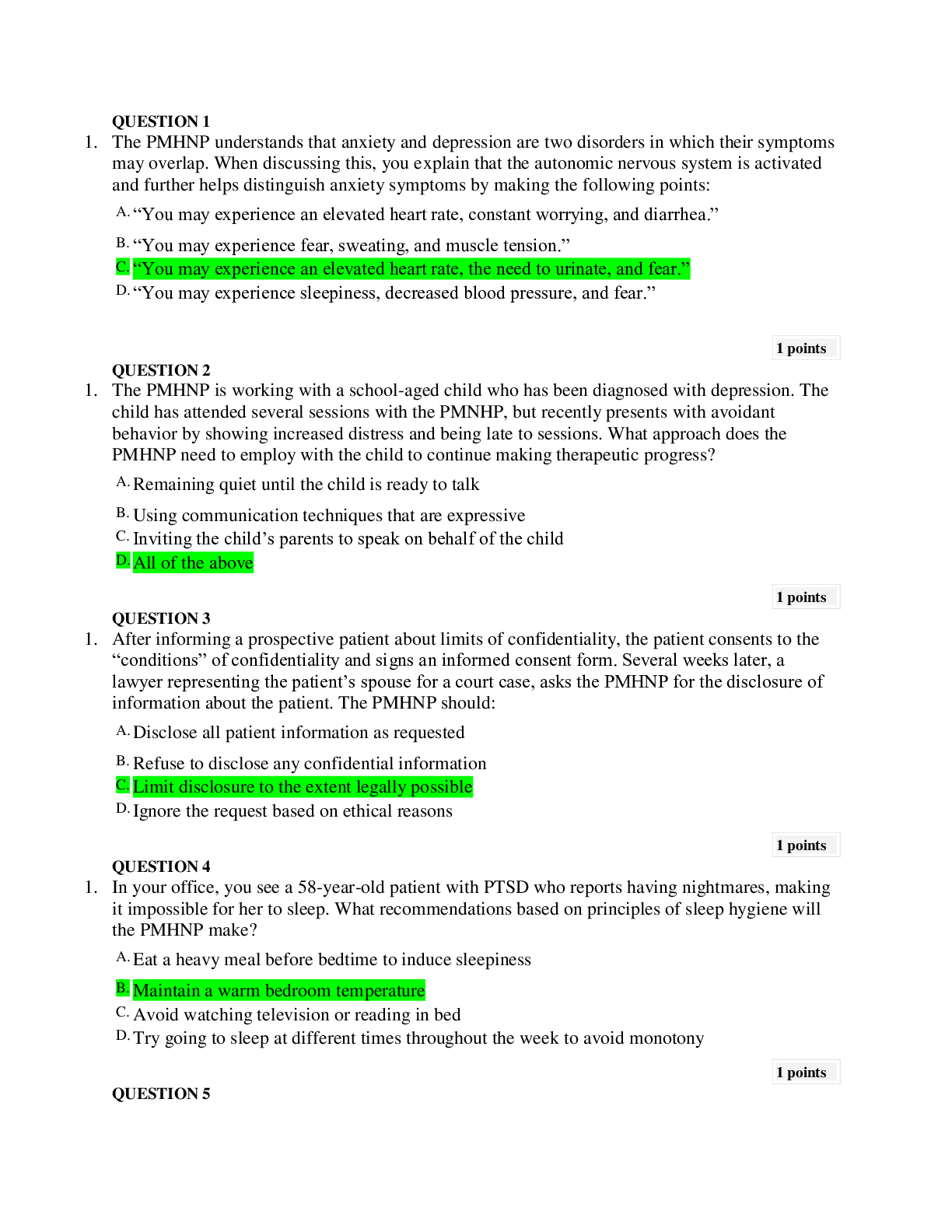
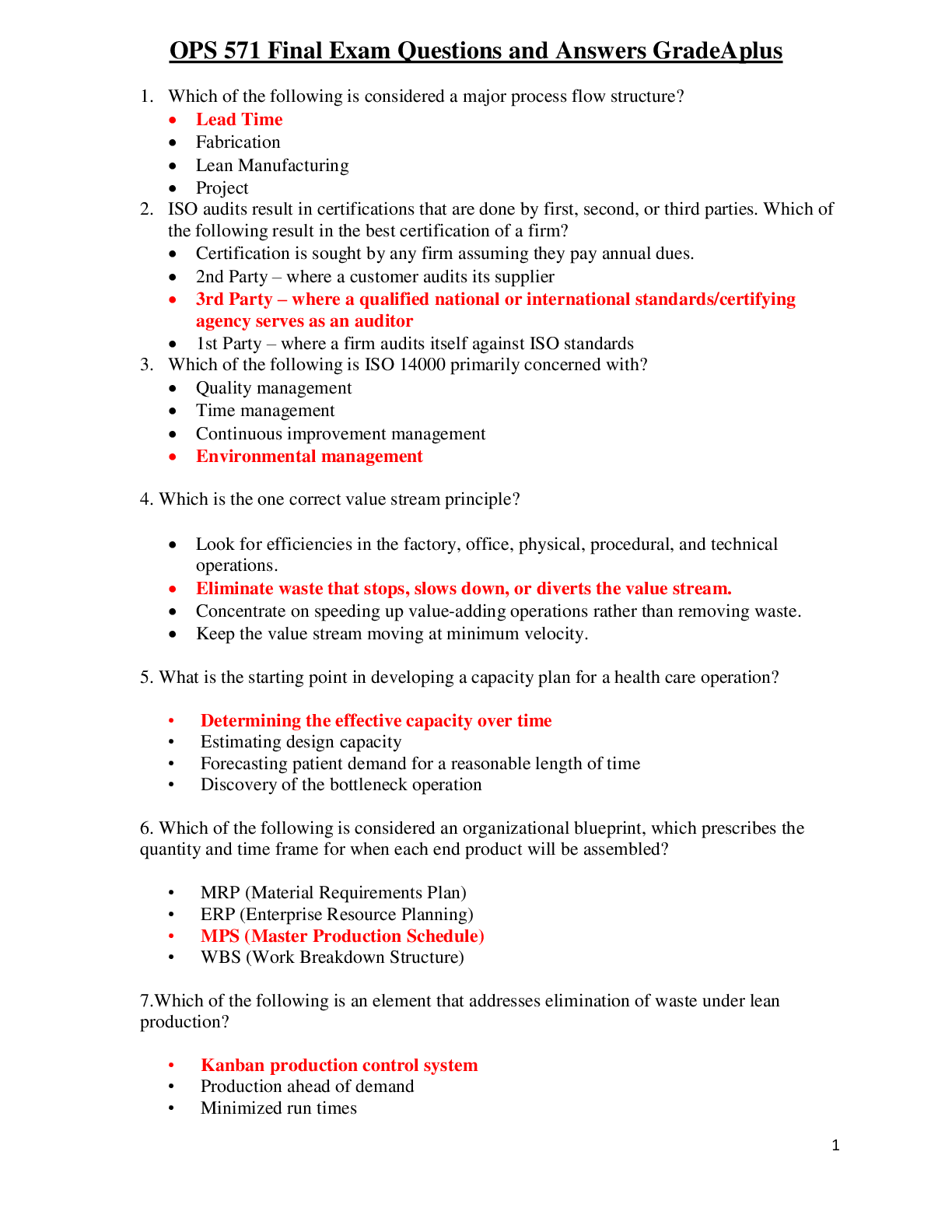
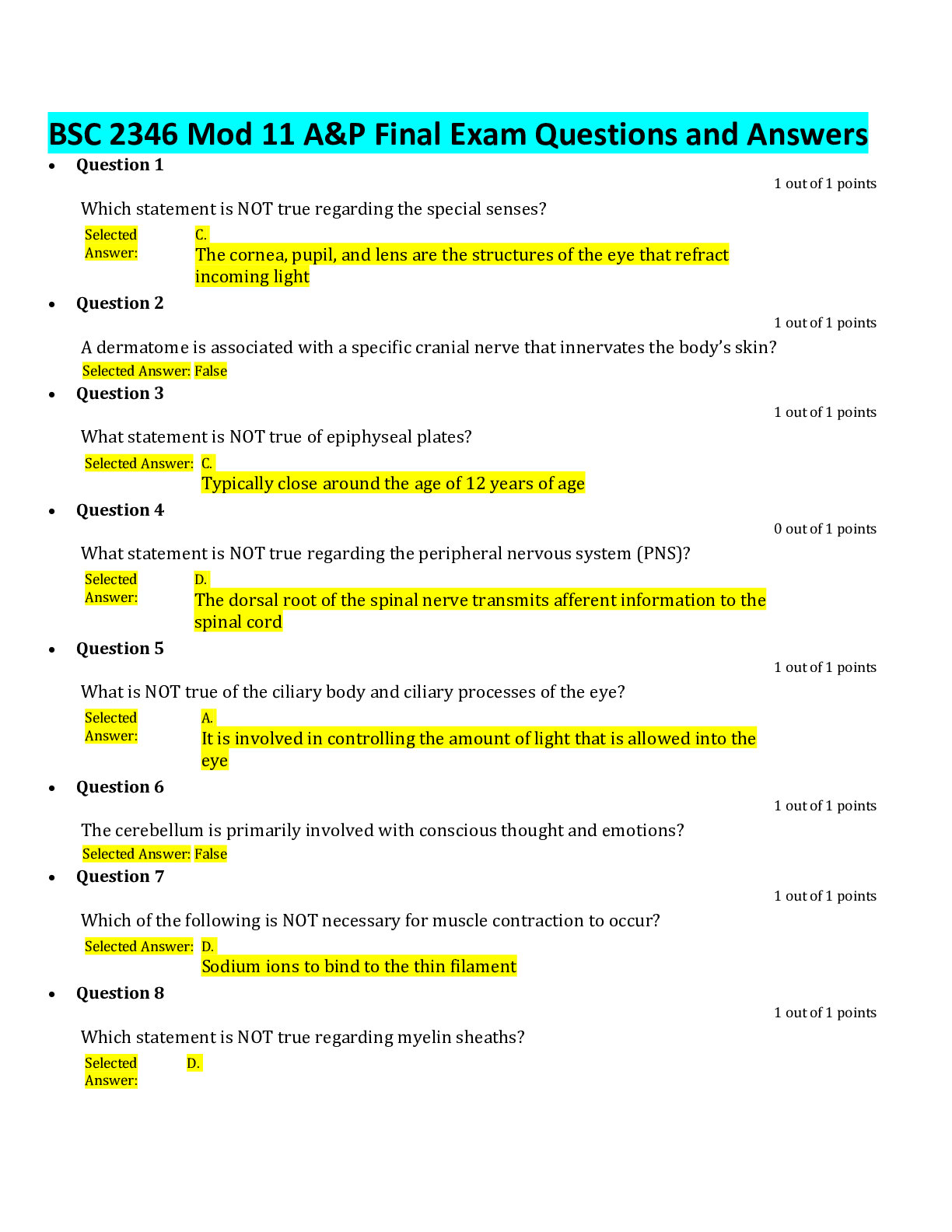


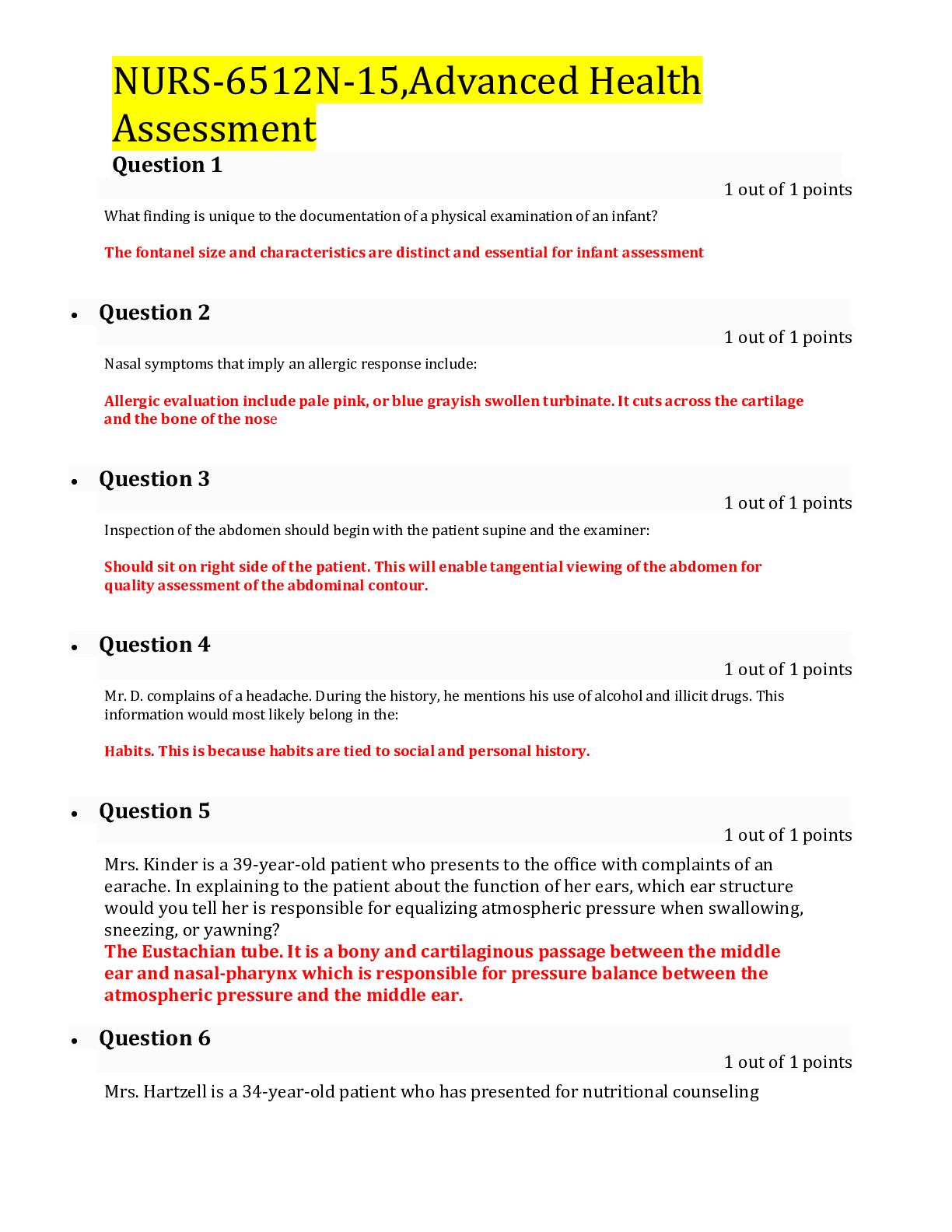
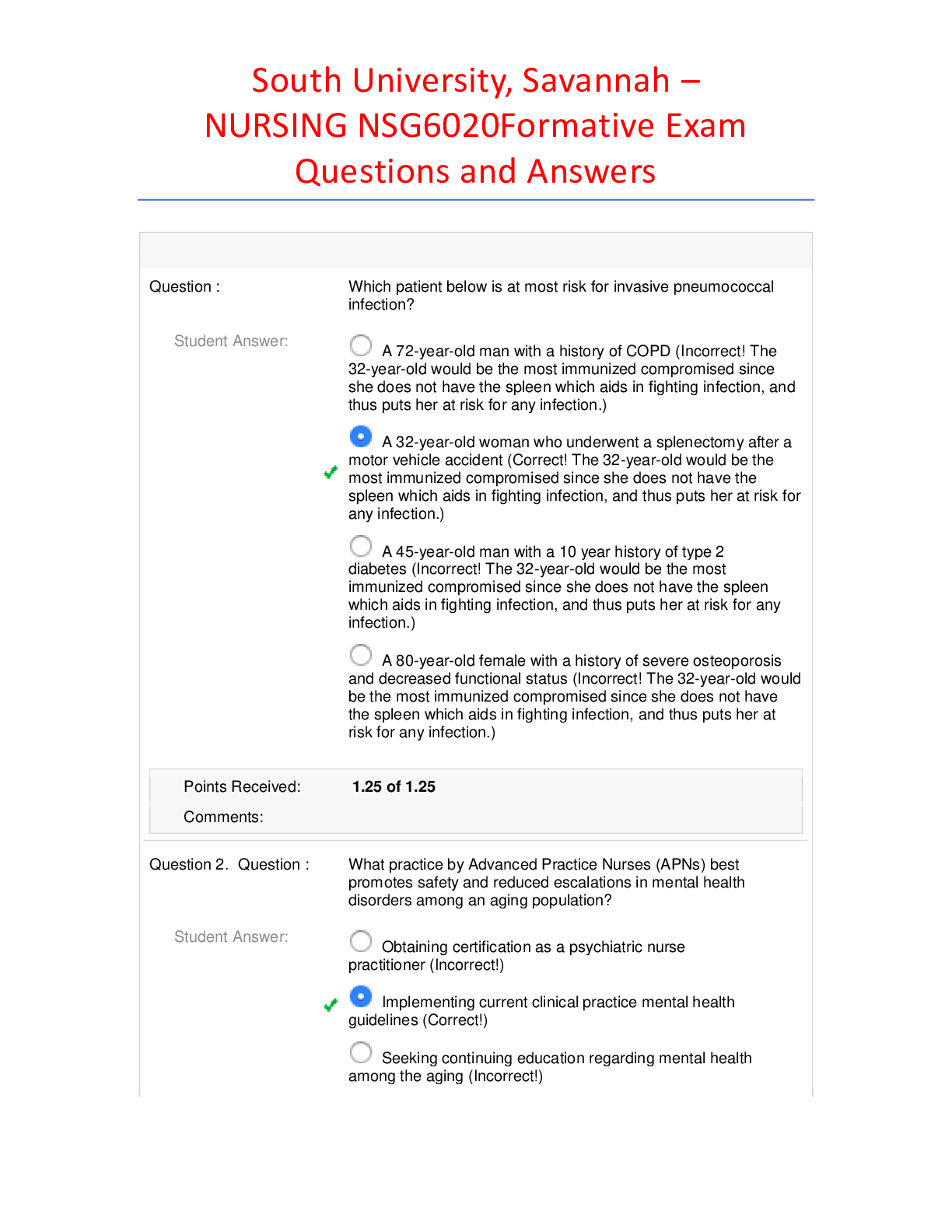
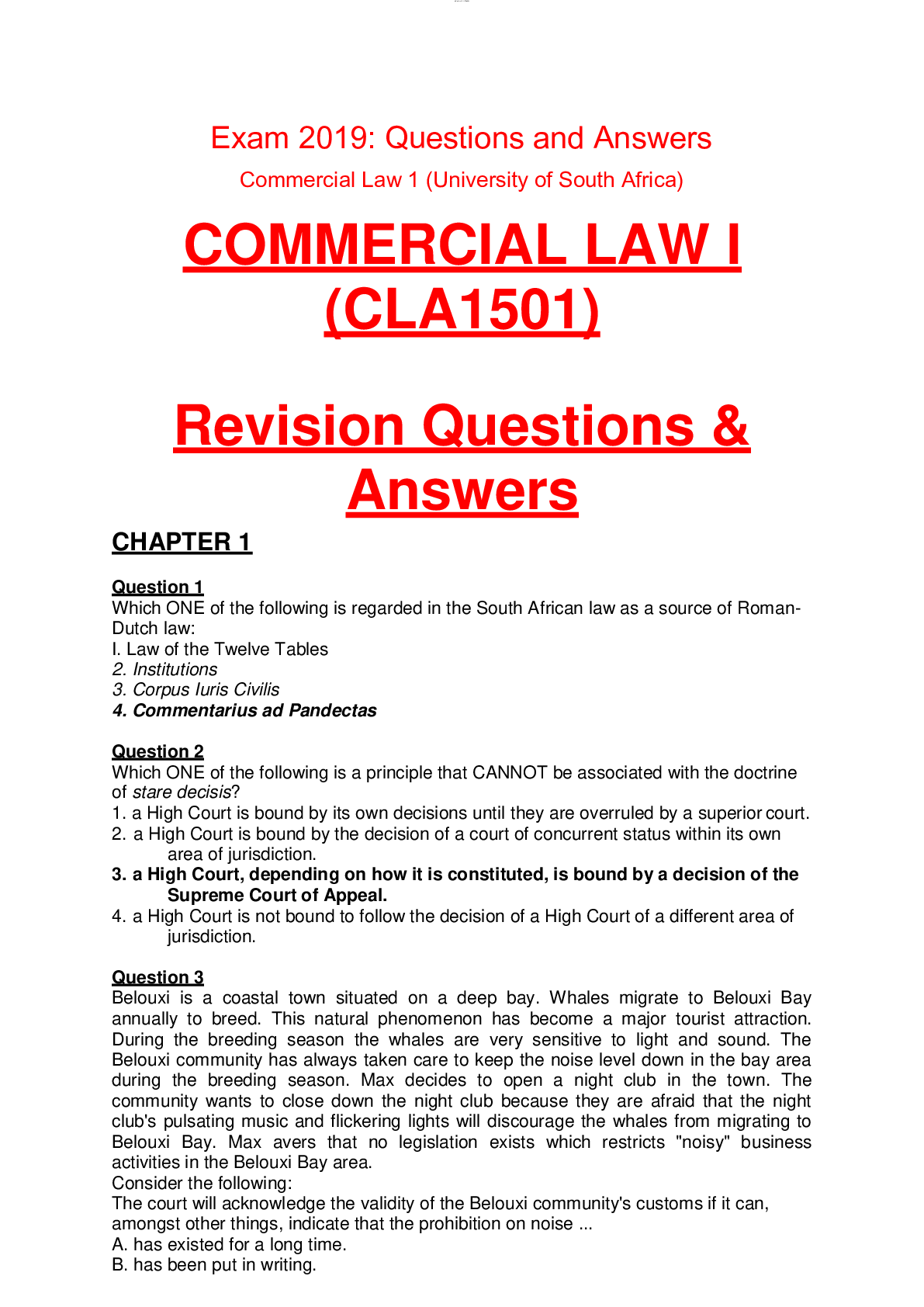

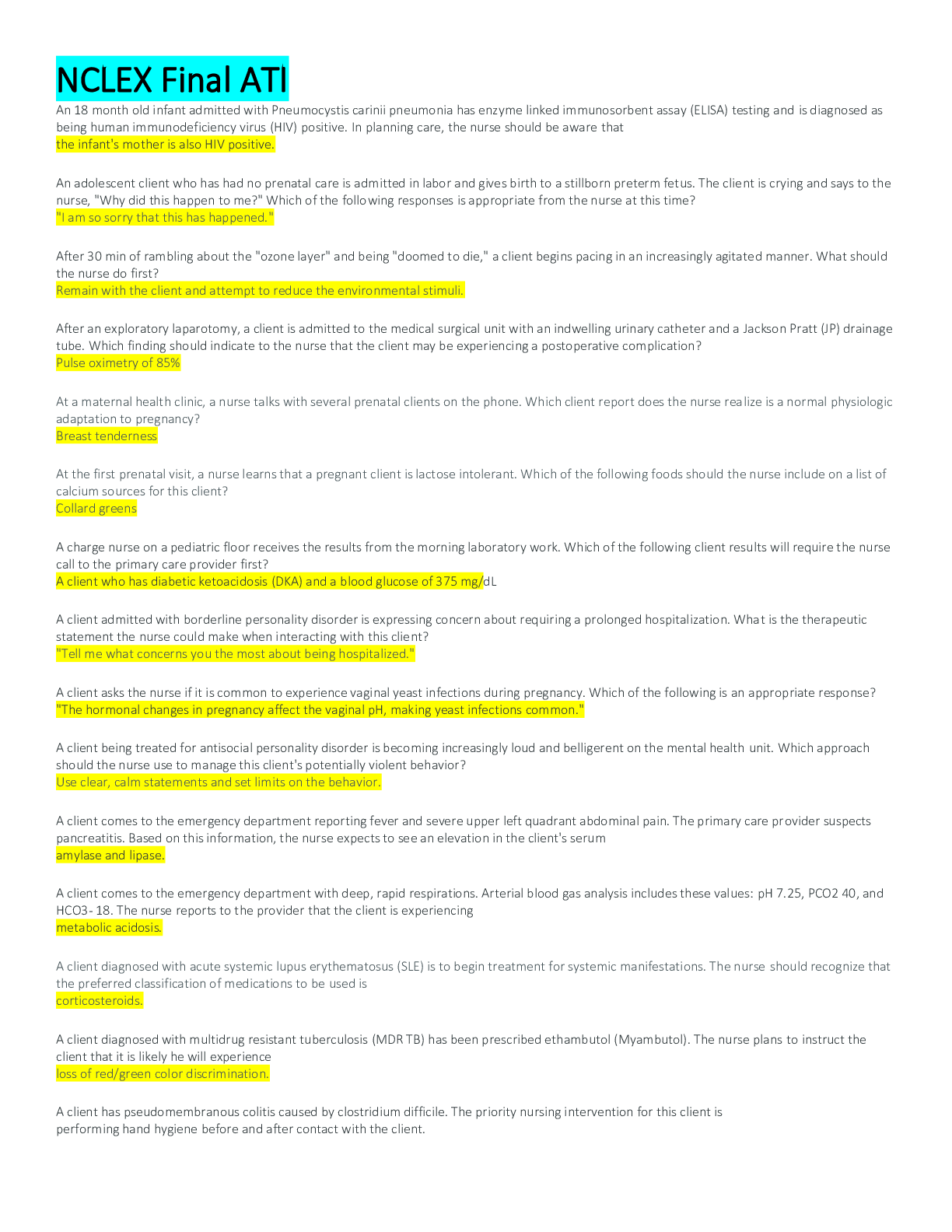
.png)


